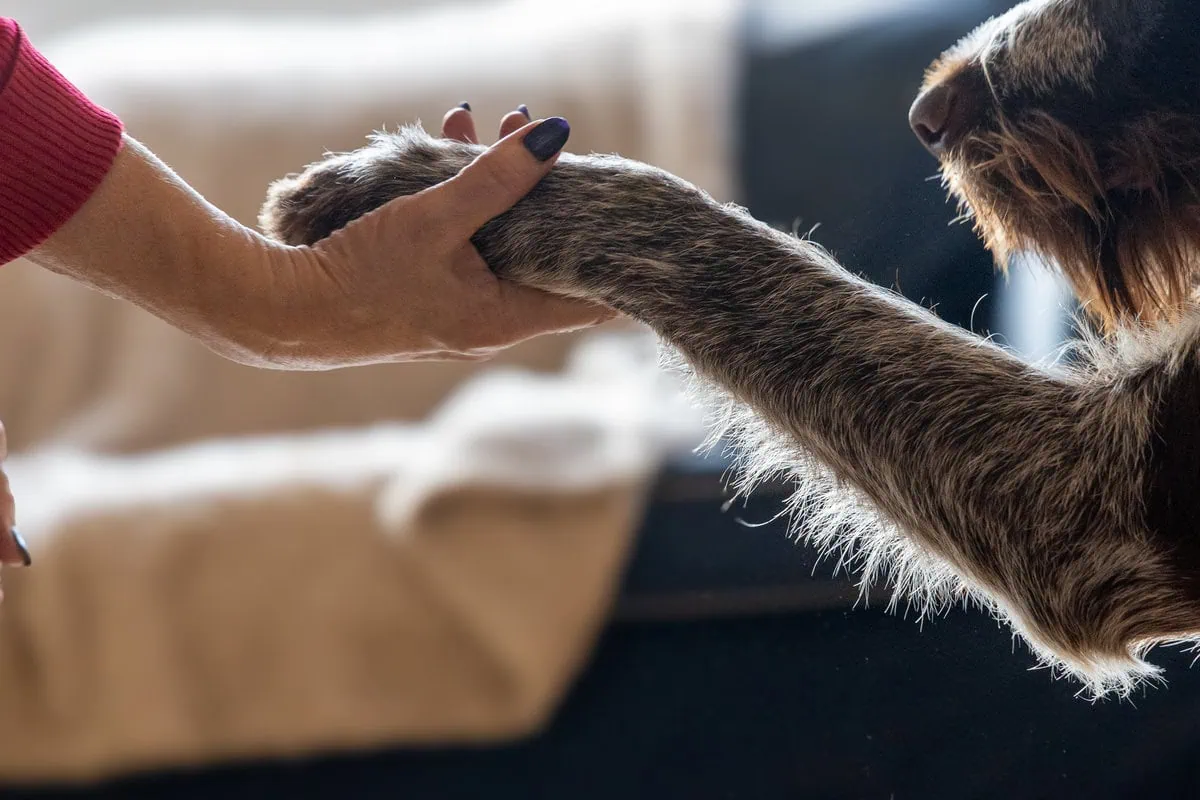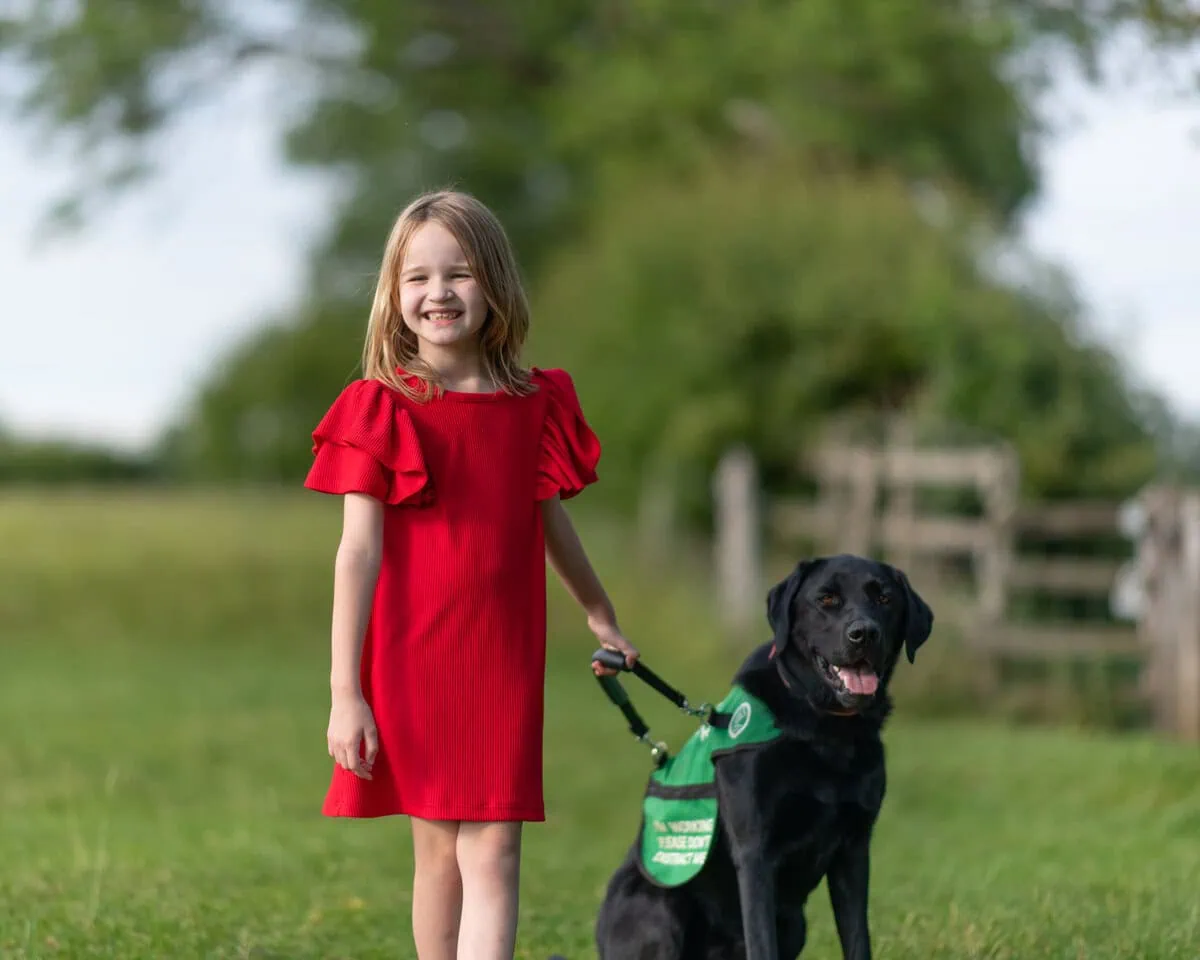
Why does this happen?
Many dogs use their mouths or paws to get our attention — not to cause harm, but as a way of inviting play or affection. This behaviour is known as mouthing and pawing. It’s most common in puppies, but some dogs continue to do it as they grow older.
Your dog may be more likely to paw or mouth when they are pleased to see you, excited, or keen to play. If you run around, make lots of noise and seem exciting, your dog will naturally want to join in. The only tools they have for play are their teeth and paws, so without guidance on how to play appropriately, they may unintentionally cause pain.
Play is a natural and important part of a puppy’s development. With their littermates, they learn vital lessons about pressure, boundaries and communication. Play continues to be valuable throughout life, offering enrichment and enjoyment, and should always be encouraged. The key is to teach your dog safer, more enjoyable ways to play. Below you’ll find some tips to help with this.
Mouthing and biting hands
Within a litter, puppies quickly learn how much pressure they can use with their teeth during play. This helps them enjoy fun interactions without hurting their brothers and sisters. Dogs’ skin is usually protected by fur, so it can cope better with sharp puppy teeth. Humans, on the other hand, have thinner, more delicate skin and aren’t used to contact with teeth, which is why mouthing can feel painful to us.
Puppies also use their mouths to explore the world around them. Picking up objects is a natural way for them to learn about their environment. While some dogs are known for having a very “soft” mouth, they are also able to carry fragile items without damage. This is usually the result of centuries of selective breeding for specific working roles. It’s not a skill that most dogs will naturally have, or even be able to learn.
Chewing
Chewing plays an important role in a dog’s wellbeing. It helps clean their teeth, keeps their jaws strong, and also satisfies their natural need to relax. Chewing can be self-soothing, helping to relieve stress and boredom, and for most dogs who enjoy it, it’s recommended they have at least 20 minutes each day to chew.
Because dogs are dependent on us to guide them, it’s our responsibility to make sure they have safe and appropriate things to chew. By providing the right options, we can help them learn good habits and enjoy all the benefits of this natural behaviour.
Teething
If your puppy is teething, this may be one of the reasons they are mouthing you. Teething can be uncomfortable, so puppies need constant access to safe teething toys, which you can find in most pet shops. Having these to hand gives your puppy an outlet for their chewing and makes it less likely they’ll direct the behaviour towards you.
Chewing helps soothe sore gums, so it’s important to offer toys that are both safe and durable. This way, your puppy can relieve discomfort while learning what’s appropriate to chew.
How to teach your dog not to mouth
If mouthing continues beyond the teething stage, which usually ends around six months, it can become harder to change. However, with patience and a consistent approach, the behaviour can be redirected and improved.
Pawing and scratching
Just as puppies need to learn not to chew or bite us, it’s equally important that they learn not to use their claws on our skin. Pawing might seem harmless, but it can cause scratches, especially for toddlers, older people, or anyone with more delicate skin. It can also damage clothing and household surfaces.
For dogs, pawing is a natural behaviour, often used to attract attention or invite play. As they grow, dogs quickly learn that repeating actions that get a response will work again. A paw on your arm may lead to you fussing them, playing with them, or even just giving eye contact and speaking. All of these things reinforce the behaviour, even if you don’t intend to.
Because we love our dogs, it’s natural to want to respond when they ask for attention. But each time we do, we strengthen the habit. If we stop, and the dog paws again and we give more attention, the behaviour becomes even more ingrained.
Dogs don’t understand how sharp their claws can be. Most also have dewclaws on their front feet, which act like thumbs to help them grip chews or gain traction. These claws can be strong and sharp, and can easily cause scratches when a dog paws downwards without realising the impact.
While pawing may look cute, it’s an example of undesirable behaviour. Your dog will need your help to learn safer, more appropriate ways to get attention. As with all training, consistency is key. If one moment pawing earns a pat and the next it doesn’t, your dog will only become confused. This is especially important in households where several people interact with the dog, as mixed messages make the behaviour harder to change.
Remember
If your dog or puppy starts to mouth or scratch you while you’re interacting with them, the best response is to stop what you’re doing and stay calm and still for a few seconds. If they remain excitable and don’t settle, redirect their energy by picking up a toy and offering it instead. Praise them for chewing or playing with the toy and encourage them to carry on, this helps them learn the safest and most enjoyable way to play.
Your dog should always have access to a variety of toys in different shapes and textures to keep them interested and satisfied. Remember, dogs and humans often have very different play styles. Patience is key, and by guiding your dog, you can help them learn how to play in a way that’s fun and rewarding for both of you.
Help support our life-changing work...
Imagine if everyday tasks were so challenging or physically demanding they affected your quality of life. For many people living with a disability or families with a child with autism, that is their reality. Now imagine if a specially trained four-legged friend could restore your, or your family’s, independence.
The demand for our services is high and we can’t help as many people as we would like to without more funding. Please help us continue to bring people and dogs together to help make everyday life possible in so many extraordinary ways.
Every contribution, whatever size, is important and helps us make a difference.
